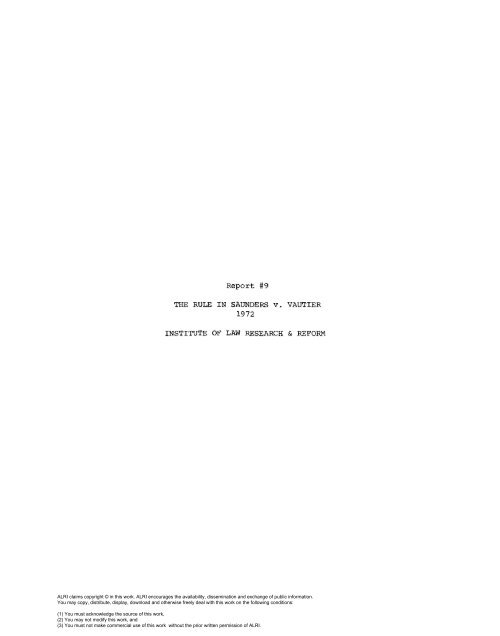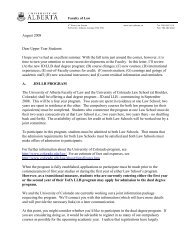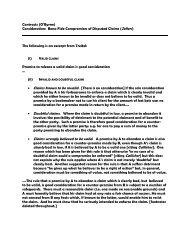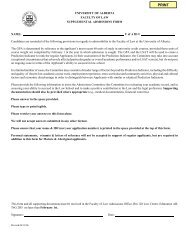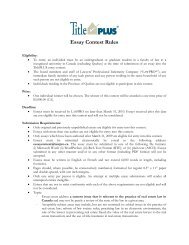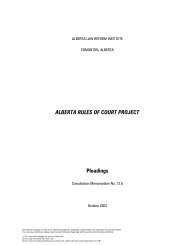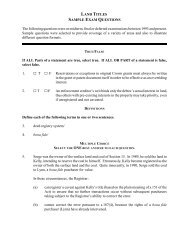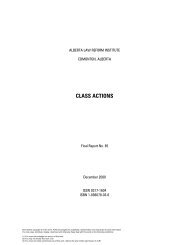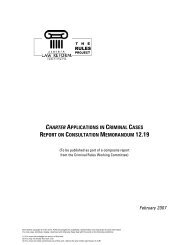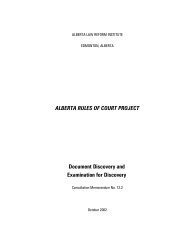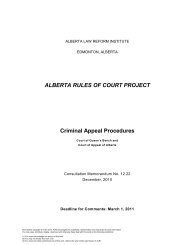Report #9 THE RULE IN SAUNDERS v. VAUTIER ... - Faculty of Law
Report #9 THE RULE IN SAUNDERS v. VAUTIER ... - Faculty of Law
Report #9 THE RULE IN SAUNDERS v. VAUTIER ... - Faculty of Law
- No tags were found...
You also want an ePaper? Increase the reach of your titles
YUMPU automatically turns print PDFs into web optimized ePapers that Google loves.
<strong>Report</strong> <strong>#9</strong><strong>THE</strong> <strong>RULE</strong> <strong>IN</strong> <strong>SAUNDERS</strong> v. <strong>VAUTIER</strong>1972<strong>IN</strong>STITUTE OF LAW RESEARCH & REFORM
TABLE OF CONTENTSPAGE NO.I. <strong>THE</strong><strong>RULE</strong>. . ..............11. RATIONALE OF <strong>THE</strong> <strong>RULE</strong>: CRITICISM:PROPOSED REFORM . .........111. <strong>THE</strong> PR<strong>IN</strong>CIPAL K<strong>IN</strong>DS OF DISPOSITIONWITH<strong>IN</strong> <strong>SAUNDERS</strong> v. <strong>VAUTIER</strong>. . ...1. Postponement to a CertainAge ..............2. Postponement to a Date. ....3. Instalment Gifts. .......4. Discretionary Trusts andPowers. ............5. Charities. ..........6. The Rule in Barford v.Street. ............IV. DETAILS OF RECOMMENDATIONS. ......V. ACKNOWLEDGEMENTS. ...........APPENDIX A.APPENDIX BSection 37 <strong>of</strong> The Trustee Act . ....Recommendations . ...........
February 18, 1972ADDENDUMA minor point to which we call attention has todo with s. 6 <strong>of</strong> the Married Women's Act, R.S.A. 1970,c. 227. Subsection (1) provides that a married woman'sproperty belongs to her as if she were an unmarriedwoman and may be disposed <strong>of</strong> accordingly. Subsection (2)provides however, as follows:"Nothing in this sectioninterferes with or renders inoperative a restriction uponanticipation or alienation attached to the enjoyment <strong>of</strong>any such property ."The consequence may be that in a situation towhich s. 6(2) applies, a married woman is one who "by reason<strong>of</strong> infancy or other incapacity is incapable <strong>of</strong> assenting"within our Recommendation #4(a). We think she should be inthe same position as any other adult for purposes <strong>of</strong> theproposed legislation.Without making a formal recommendation, we shall setout a provision that would eliminate any doubt:<strong>THE</strong> JURISDICTION CONFERRED UPON <strong>THE</strong> COURT UNDERTHIS ACT SHALL <strong>IN</strong>CLUDE <strong>THE</strong> POWER TO VARY ANYDISPOSITION OF PROPERTY, NOTWITHSTAND<strong>IN</strong>G THAT<strong>THE</strong> DISPOSITION CONTA<strong>IN</strong>S A REST17TCTTON UPONANTICIPATION OR ALIENATION ATTACHED TO <strong>THE</strong>ENJOYMENT OF ANY SUCH PROPERTY; AND FOR <strong>THE</strong>PURPOSES OF THIS ACT SUBSECTION I21 OF SECTION6 OF <strong>THE</strong> MARRIED WOMEN'S ACT SHALL BE CONSTRUEDACCORD<strong>IN</strong>GLY.Parenthetically we note that protective trusts <strong>of</strong>the type provided for in s. 33 <strong>of</strong> the English Trustee Actmight be the subject <strong>of</strong> a separate study; likewise theMarried Women's Act. The latter will doubtless come underconsideration in our Family <strong>Law</strong> project,
<strong>IN</strong>STITUTE OF LAW RESEARCH AND REFORMREPORTThe Rule in Saunders v. Vautier<strong>THE</strong> <strong>RULE</strong>Sometime ago the Institute decided to make anexamination <strong>of</strong> various rules in the law <strong>of</strong> wills andtrusts which have been subject to criticism. The purpose<strong>of</strong> our study is to see whether the rules should be altered,and if so what the new provisions should be. One <strong>of</strong>these rules is called the rule in Saunders v. Vautier.Theobald on wills, 12 ed. (1963) para.1539 states therule as follows:Where there is an absolute vested giftmade payable at a future event, with adirection to accumulate the income in themeantime and pay it with the principa1,thecourt will not enforce the trust for accumulation,in which no person has any interestbut the legatee.In Saunders v. Vautier itself (1841), 41 E.R. 482 the testatorgave East India stock to trustees to accumulate the incomeuntil his great-nephew, Daniel Vautier, should attain theage <strong>of</strong> 25 years, and then to transfer the stock and accumulationsto him. The testator died in 1832 and Daniel attained21 in 1841. Wanting the principal, he petitioned for atransfer to him. Lord Cottenham L.C. construed the gift asvested on the testator's death, and not contingent on Daniel
attaining 25. Next he pointed out that there was no giftover in the event <strong>of</strong> Daniel's death under 25. Thus he cancall for the property on attaining his majority, althoughthe testator intended that the enjoyment <strong>of</strong> it should bepostponed until he attained 25. In Gosling v. Gosling(18591, 70 E.R. 423 the disposition was similar to thatin Saunders v. Vautier, though the subject matter was adevise <strong>of</strong> land. The court held that the testator's desireto postpone enjoyment <strong>of</strong> the land was simply ineffective.Sir W. Page Wood V.C. said:The principle <strong>of</strong> this Court has alwaysbeen to recognize the right <strong>of</strong> all personswho attain the age <strong>of</strong> twenty-one to enterupon the absolute use and enjoyment <strong>of</strong> theproperty given to them by a will, notwithstandingany directions by the testator tothe effect that they are not to enjoy ituntil a later age--unless, during theinterval, the property is given for thebenefit <strong>of</strong> another, If the property isonce theirs, it is useless for the testatorto attempt to impose any fetter upon theirenjoyment <strong>of</strong> it in full so soon as theyattain twenty-one. And upon that principle,unless there is in the will, or in somecodicil to it, a clear indication <strong>of</strong> anintention on the part <strong>of</strong> the testator, notonly that his devisees are not to have theenjoyment <strong>of</strong> the property he has devised tothem until they attain twenty-five, but thatsome other person is to have that enjoyment--or unless the property is so clearly takenaway from the devisees up to the time <strong>of</strong>their attaining twenty-five as to inducethe Court to hold that, as to the previousrents and pr<strong>of</strong>its, there has been an intestacy--the Court does not hesitate to strike out <strong>of</strong>the will any direction that the devisees shallnot enjoy it in full until they attain the age<strong>of</strong> twenty-five years.
party until the date <strong>of</strong> distribution, or he can providefor a gift over to a third party on the beneficiary'sdeath prior to the time at which the testator wishesthe property to be transferred. The fact is, however,that testators frequently overlook such a provision andit requires skilled and careful draftsmanship.RATIONALE OF <strong>THE</strong> <strong>RULE</strong>: CRITICISM:PROPOSED REFORMWhere A puts property in trust for B (who is <strong>of</strong> age)so that B is the absolute owner and no one else has even apotential interest in the property, then any effort by A,in the instrument creating the trust, to control B'senjoyment <strong>of</strong> the property is ineffective.A no longerowns the property and his attempts to remove from B any<strong>of</strong> the incidents <strong>of</strong> ownership, including the right <strong>of</strong>immediate enjoyment, is repugnant to the gift and henceineffective .The rule has been followed in the common law provinces,Australia and New Zealand. In the United States however, ithas in general been rejected in favour <strong>of</strong> a "material purpose"doctrine. Under this doctrine the court will not terminatethe trust if the "material purpose" which the testator hadin mind has not yet been carried out. In the leading case<strong>of</strong> Claflin v. Claflin (1889), 149 Mass. 19, the testatorgave the income to A and, as testators frequently do, gavethe capital to him in three instalments at the age <strong>of</strong> 21,25 and 30 years. The court held that A was not entitled tocapital on attaining 21; the testator's intent must not befrustrated. This case formulated the "material purpose"
doctrine. The testator's material purpose was to providethe capital as A became older and that purpose would bedefeated by giving the money to A on attaining 21. Thecommon examples <strong>of</strong> a material purpose are those in whichpayment <strong>of</strong> a gift has been postponed to a specific date,to a specific age, or where there is payment by instalments.In Canada the rule in Saunders v. Vautier has notgone without criticism. In Re Townshend, [1941] 3 D.L.R.609, Chief Justice Baxter <strong>of</strong> New Brunswick consideredhimself obliged to apply the rule, though it compelled thecourt "to depart from common sense" and "to disregard thewishes <strong>of</strong> the testator".We think that the rule should be changed. Thetheoretical consequence <strong>of</strong> absolute ownership should notoperate automatically to defeat the testator's intention.The law allows him to make the gift, and there should beno rule <strong>of</strong> "legal theology" to prevent him from imposingrestrictions upon enjoyment even when the ownership isvested and indefeasible.We realize <strong>of</strong> course that a testator who wants toavoid Saunders v. Vautier can do so by careful drafting.In the typical case where he wishes to have payment postponed,he can provide for a gift over should the beneficiarydie before the prescribed date. The fact is that gifts arenot always framed in a way to ensure this; and the lawshould not lay traps which require sophistication to avoid.Further, the fact that the rule can be got around by carefuldrafting actually invalidates any rationale for it. Thereis no point to a rule which merely penalizes poor drafting
and there is nothing to be said for a policy which can begot around by a different form <strong>of</strong> words.We recognize, too, that courts frequently dislikethe consequences <strong>of</strong> Saunders v. Vautier and may go toconsiderable lengths to avoid them by construing thedisposition in a way that will leave it outside the rule.Re Burns (19611, 25 D.L.R. (2d) 427 (Alta. App. Div.) isperhaps an example, and - Fast v. Van Vliet (1965), 51 W.W.R65 (Man. C.A.) is another.To leave the rule as it is is to accept the choicethat the beneficiary's wishes prevail over the testator's.A complete repeal would reverse the position. In largemeasure this is what the American material purpose doctrinedoes. However we do not think that statutory provisionsembodying that doctrine would be wise if for no otherreason than that it is <strong>of</strong>ten hard to determine whether thereis a material purpose.We think that the best course is to replace Saunders v.Vautier to the extent <strong>of</strong> giving to the court power to decidewhether to permit termination or variation <strong>of</strong> the trust.This will permit the court to take cognizance <strong>of</strong> the donor'sintenk, which is ignored when Saunders v. Vautier applies,and also the interest <strong>of</strong> the donee. We believe the donor'swishes should be recognized. But he may not foresee thecircumstances which occur and his true intention may bedefeated by the establishment <strong>of</strong> a rule on the lines <strong>of</strong> thematerial purpose doctrine. A change in the value <strong>of</strong> moneyor the state <strong>of</strong> the beneficiary's health may render inadequatea provision for periodic payments which was intended
Saunders v. Vautier and its complete abolition. The onlycriterion will be that so far as the adult beneficiary isconcerned, the court thinks the variation or termination<strong>of</strong> the trust to be justifiable.<strong>THE</strong> PR<strong>IN</strong>CIPAL K<strong>IN</strong>DS OF DISPOSITION WITH<strong>IN</strong><strong>SAUNDERS</strong> V. <strong>VAUTIER</strong>Before going into details <strong>of</strong> our recommendation, wethink it helpful to describe the main types <strong>of</strong> dispositionto which the rule applies.1. Postponement to a Certain AgeSaunders v. Vautier itself is an example. It iscommonplace for testators to wish to delay payment <strong>of</strong> theprincipal to a beneficiary, particularly if he is young.Postponement is frequently to an age between 23 and 30.Canadian cases in which the rule has been applied to adisposition <strong>of</strong> this kind are:Re Townshend, [1941] 3 D.L.R. 609 (N.B.)Re Squire (1962), 34 D.L.R. (2d) 481 (Ont.)Re Mallory, [I9511 O.W.N. 661 (Ont.)The invocation <strong>of</strong> Saunders v. Vautier will <strong>of</strong> coursefail if the court finds the gift to be contingent as it didin the following cases:Re waines, 119471 1 W.W.R. 880 (Alta. App. Div.)F a s t a n Vliet (1965), 51 W.W.R. 65 (Man. C.A.)RecCallum, I19561 O.W.N. 321Re Down (1968), 68 D.L.R. (2d) 30 (Ont. C.A.)
Where there is a gift over on the beneficiary'sdeath before attaining the prescribed age, the gift issometimes construed as vested but defeasible. In thesecircumstances Saunders v. Vautier cannot apply. Thebeneficiary is entitled however to the income from thetime <strong>of</strong> vesting. SeeRe Barton, 119411 S.C.R. 426Re Stedman, 119481 2 W.W.R. 687 (Alta.)2. Postponement to a DateThe testator may make an outright gift and then lateradd a provision for payment or transfer <strong>of</strong> the subject matterto the beneficiary on January lst, 1975, or five years afterthe testator's death. The court will have to decide whetherthe gift is vested or contingent by application <strong>of</strong> the ruleslaid down in Browne v. Moody, 119361 A.C. 635. If the giftis held to be vested the rule in Saunders v. Vautier willapply, but a gift over should the beneficiary die beforethe prescribed date has the effect <strong>of</strong> excluding the rule.Re Boudreau (1965), 47 D.L.R. (2d) 584 (N.B. App. Div.)- gift overRe Winn (1968), 66 D.L.R. (2d) 182 (Sask.) - contingent3. Instalment GiftsIn the typical case the testator makes an outright giftand then directs the executor to pay the beneficiary ininstalments <strong>of</strong> $200 a month until the gift is exhausted.In the following cases the court applied Saunders v. Vautier:
Montreal Trust Co. v. Krisman, 119601 S.C.R. 659Re Price (1966), 55 W.W.R. 26 (Sask.)Re Dawson, 119411 1 W.W.R. 177 (Alta.)Re Burger, 119491 1 W.W.R. 280 (Alta.)The last two cases are in the Alberta Trial Division.In Dawson the testatrix left one-quarter <strong>of</strong> the residue toher son John, to be paid to him at $60 a month, any balanceon his death to go to his estate.In Burger the testatorleft one-third <strong>of</strong> his net estate to his wife, to be paidto her at the rate <strong>of</strong> $200 a month.The testator could<strong>of</strong> course have avoided Saunders v. Vautier by providingfor a gift over should the beneficiary die before the whole<strong>of</strong> his share has been paid out to him (e.g., Montreal TrustCo. v. Klein, [19711 4 W.W.R. 644 sub nom Re Schumacher 20- --D.L.R. (3d) 487 (Man. C.A.)) . In one case, Re Eves (1965),50 D.L.R. (2d) 88 (Sask.), the court construed the gift asan annuity rather than a gift <strong>of</strong> the capital, so Saunders v.Vautier did not apply.4. Discretionary Trusts and PowersSometimes a will gives to the trustees the power <strong>of</strong>discretion to pay sums out <strong>of</strong> a specified fund to a beneficiaryor class <strong>of</strong> beneficiaries. If the discretion permitstrustees to pay nothing, then the beneficiaries cannot invokeSaunders v. Vautier; but if the trustees must distributethe whole fund among specific beneficiaries or a class <strong>of</strong>beneficiaries then the rule will apply. Cases in whichbeneficiaries <strong>of</strong> a discretionary trust have succeeded inacquiring the capital under Saunders v. Vautier are:Re ~amilton (19131, 27 O.L.R. 445Re Mckeon (1913), 25 O.W.R. 146Re Johnston (1965), 48 D.L.R. (2d) 573 (B.C. )
5. CharitiesIn the leading case <strong>of</strong> Wharton v. Masterman, 118951A.C. 186 the testator directed certain annuities to bepaid, the surplus income to be invested and after thedecease <strong>of</strong> the last surviving annuitant the trustees wereto hold the capital and accumulations in trust for fivecharitable institutions. It is important to note thatif the income were not sufficient in any year to pay thewhole <strong>of</strong> the annuities, they should abate. In other wordsthey were not charged on the capital. The House <strong>of</strong> Lordsheld that the charities were entitled to stop the accumulationand have immediate payment <strong>of</strong> the fund though some<strong>of</strong> the annuitants were still alive. The charities wereprepared to secure the annuitiesIn the later case <strong>of</strong> Berry v. Geen, [I9381 A.C. 575 -the House <strong>of</strong> Lords distinguished Wharton on the ground thatin Berry the annuity was charged on capital.The charitycould not ask for the capital under Saunders v. Vautierand at the expiration <strong>of</strong> 21 years from the testator'sdeath the Accumulations Act forbade further accumulations.As a result the "released" income went to the next <strong>of</strong> kin.In Re Burns (1961), 25 D.L.R. (2d) 427 the AlbertaAppellate Division applied Berry v. - Geen. However in Re -Burns, not all <strong>of</strong> the released income went to the next <strong>of</strong>kin. The will had given part <strong>of</strong> the capital and accumulationsto individuals and part to specific charities. Aportion <strong>of</strong> the released income came from the capital belongingto the charities. The court found that the gift to thecharities showed a general charitable intent so that the
income released from the capital should go to a charitablepurpose under the 2-pres doctrine. The court directedthat a scheme be submitted for approval by the court.In Re Birtwistle, 119351 4 D.L.R. 137 (Ont.) the courtrefused to approve an agreement between the trustee and theTown <strong>of</strong> Colne in England, the beneficiary <strong>of</strong> the capital,for payment immediately <strong>of</strong> the capital to it. The settlorhad directed that there should be an accumulation for 21years, and that capital and accumulations should then go tothe Town, to be used for the benefit <strong>of</strong> the poor <strong>of</strong> the Town.Although the Town had a strong case under Saunders v. Vautier,the court doubted that the rule applied. Even if the giftwas vested, the real beneficiary was not the Town, but thepoor. This was a main reason for the court's refusal toapprove thk agreement.6. The Rule in Barford v. Street (1809), 16 Vesey Jr. 135Where a testator gives to the beneficiary a lifeinterest together with a power to appoint by deed or will,or by deed alone, the beneficiary can appoint to himself.The leading Canadian case is Re Mewburn, 119391 S.C.R. 75.The testator left one-half <strong>of</strong> the residue to a daughterH for life "and upon her death said share shall go and bedisposed <strong>of</strong> as she may by deed or will appoint", with agift over on default <strong>of</strong> appointment. On the testator'sdeath H requested a transfer <strong>of</strong> the corpus. In theAppellate Division, Harvey C.J. for the majority thoughtthat this would defeat the testator's intention and thatno rule <strong>of</strong> law required the court to hold in H's favour.Her appeal was successful. The Supreme Court held that "she
is able to exercise the power and disregard the testator'swishes. "Cases applying Re Mewburn are:Re Jones, I19491 3 D.L.R. 604 (Man. C.A.)Re Southam, 119553 1 D.L.R. 438 (Ont.)Where the power is exercisable by will alone, thegeneral rule is that the donee <strong>of</strong> the power cannot appointto himself, but even in that case he may be able so to do ifthe gift over on default <strong>of</strong> appointment is to his estate.Middleton J. so held in Re Hooper (1914), 7 O.W.N. 104 andin Re Campbell (1919), 17 0.W .N. 23.However both in Re Mewburn and Berwick v. Canada TrustCo., - 119481 S.C.R. 151, the Supreme Court at least impliedthat where the power is exercisable by will alone, the personhaving the power may not appoint to himself. On the otherhand Re Johnston (1965), 48 D.L.R. (2d) 573 (B.C.) holdsthat the donee <strong>of</strong> the power can appoint to herself eventhough the power is exercisable only by will and apparentlywhere there is no gift to the donee's estate on default <strong>of</strong>appointment.Thus the law in Canada is somewhat obscure in the case<strong>of</strong> a power exercisable by will alone, though if Re Mewburnoperates to defeat the testator's intention, then - a fortioridoes a ruling that in the case <strong>of</strong> a power exercisable bywill alone the donee may demand the corpus.There are two other situations which literally maynot be applications <strong>of</strong> Saunders v. Vautier but which areso close thereto that they can properly be considered here.
(1) The first is the commonplace example <strong>of</strong> a lifeinterest followed by a vested remainder where both lifetenant and remainderman are sui juris. The life tenantmay acquire the interest <strong>of</strong> the remainderman or theremainderman may acquire the interest <strong>of</strong> the life tenant.In either case a single person now is the sole and absoluteowner <strong>of</strong> the property and can call on the trustee to conveyit to him. The result is a disposition substantiallydifferent from that provided in the will, and one that inall probability the testator would not have wanted.(2) A testator may direct his trustees to investa specified sum in an annuity for his widow or daughteror someone else.In general the courts have held that thebeneficiary, being sui juris, can call for the capital.The reason given in the leading case <strong>of</strong> Barnes v. Rowley(17971, 30 E.R. 1024, is that even were the trustees to buythe annuity the beneficiary could sell it and thus obtainthe capital so it would be futile to refuse the application.In Re Boxall, 119461 3 W.W.R.413, the testator directedthe trustees to invest the residue in a Dominion <strong>of</strong> Canadaannuity for his daughter.The Saskatchewan Court <strong>of</strong> Appealrefused her application that the trustee pay the capitalto her.The payment <strong>of</strong> the capital to the daughter wouldhave defeated the testator's intent.The statute providingfor the annuity rendered inalienable the benefits under theannuity contract, so the argument that refusal <strong>of</strong> thebeneficiary's application would be futile, was not availableto the daughter.This case produced a debate between thelate Pr<strong>of</strong>essor E. Whitmore who approved the decision andD. M. Gordon, Q.C., who disapproved. The latter thoughtthat Saunders v. Vautier applies (24 Can. Bar Rev. 818;25 Can. Bar Rev. 117, 121) .
It is relevant to ask: is each <strong>of</strong> the last twocases, that <strong>of</strong> merger <strong>of</strong> successive interests and that <strong>of</strong>the direction to trustees to buy an annuity, within therecommendations that follow? We think they are both withinour basic recommendation, which is #l.To conclude this Part, we repeat the criticism wemade in Part 11. Each <strong>of</strong> the dispositions we have described,and to which the rule applies, is a sound arrangement toprovide for the family <strong>of</strong> the testator or settlor. Yeteach can be totally frustrated by a sane eighteen-year oldwho learns <strong>of</strong> the technical rule called Saunders v. Vautier.Moreover, the question arises whether the dutiful trustee isbound to tell him about it. The trustee should not be putin that position.We have already mentioned the disastrous results, interms <strong>of</strong> the testator's intent, <strong>of</strong> omitting a gift over,and also the fact that, in the absence <strong>of</strong> a gift over,difficult questions <strong>of</strong> construction arise as to whetherthe gift is vested or contingent. (This is the constructionalchess game, as Pr<strong>of</strong>essor Waters describes it, and illustrated-by cases like Re Waines and Fast v. Van Vliet.)DETAILS OF RECOMMENDATIONSWe propose a somewhat lengthy section which incor-porates the present s. 37 and extends its application tothe rule in Saunders v. Vautier.
The recommended enactment will have nine subsections.We shall set the recommendations out in order, with anexplanatory comment preceding each. They will be instatutory form though we realize the legislative draftsmanmay change the organization and wording.The basic recommendation is that the variation ortermination <strong>of</strong> a trust prior to the period <strong>of</strong> its durationas specified by the terms <strong>of</strong> the trust shall require theconsent <strong>of</strong> the court.This puts an end to the rule inSaunders v. Vautier but instead <strong>of</strong> stopping there and thuscreating the American rule, it goes on and gives the courtpower to decide between upholding the donor's wishes-- in toto, or contrariwise the donee's wishes -- in toto, orto approve a disposition between these two extremes.It will be noted that the following recommendationis prospective. We considered whether it could properlybe made applicable to trusts existing before the newprovision comes into force, and concluded not to make itretroactive.RECOMMENDATION #I(1) SUBJECT TO ANY TRUST TERMS RESERV<strong>IN</strong>G APOWER TO ANY PERSON OR PERSONS TO REVOKEOR <strong>IN</strong> ANY WAY VARY <strong>THE</strong> TRUST OR TRUSTS,NO TRUST ARIS<strong>IN</strong>G AFTER <strong>THE</strong> COM<strong>IN</strong>G <strong>IN</strong>TOFORCE OF THIS SECTION, WHATEVER <strong>THE</strong> NATUREOF <strong>THE</strong> PROPERTY <strong>IN</strong>VOLVED, AND WHE<strong>THE</strong>RARIS<strong>IN</strong>G BY WILL, DEED, OR O<strong>THE</strong>R DISPOSITION,SHALL BE VARIED OR TERM<strong>IN</strong>ATED BEFORE <strong>THE</strong>EXPIRATION OF <strong>THE</strong> PERIOD OF ITS NATURALDURATION AS DETERM<strong>IN</strong>ED BY <strong>THE</strong> TERMS OF<strong>THE</strong> TRUST, EXCEPT BY CONSENT OF <strong>THE</strong> COURT.
Our next recommendation is designed to specify indetail the different types <strong>of</strong> case to which the provisionapplies. We think this helpful as a reminder <strong>of</strong> themain factual situations to which Saunders v. Vautierapplies and which have been discussed above. The followingsubsection is intended to cover all <strong>of</strong> them except thatwhich is the subject <strong>of</strong> the rule in Barford v. Street.(2) FOR <strong>THE</strong> PURPOSES OF THIS SECTION, BUTNOT SO AS TO RESTRICT <strong>THE</strong> GENERALITYOF SUBSECTION (1) OF THIS SECTION,SUBSECTION (1) SHALL <strong>IN</strong>CLUDE(a) ANY <strong>IN</strong>TEREST UNDER A TRUST WHERE-UNDER <strong>THE</strong> TRANSFER OR PAYMENT OF<strong>THE</strong> CAPITAL OR OF <strong>THE</strong> <strong>IN</strong>COME,<strong>IN</strong>CLUD<strong>IN</strong>G RENTS AND PROFITS(i) IS POSTPONED TO <strong>THE</strong> ATTA<strong>IN</strong>-MENT BY <strong>THE</strong> BENEFICIARY ORBENEFICIARIES OF A STATEDAGE OR STATED AGES; OR(iil IS POSTPONED TO <strong>THE</strong> OCCUR-RENCE OF A STATED DATE ORTIME OR <strong>THE</strong> PASSAGE OF ASTATED PERIOD OF TIME; OR(iii) IS TO BE MADE BY <strong>IN</strong>STALMENTS;OR(iv) IS SUBJECT TO A DISCRETION TOBE EXERCISED DUR<strong>IN</strong>G ANY PERIODBY EXECUTORS AND TRUSTEES, ORBY TRUSTEES, AS TO <strong>THE</strong> PERSONOR PERSONS WHO MAY BE PAID ORRECEIVE <strong>THE</strong> CAPITAL OR <strong>IN</strong>COME,<strong>IN</strong>CLUD<strong>IN</strong>G RENTS AND PROFITS, ORAS TO <strong>THE</strong> TIME OR TIMES AT WHICH
OR <strong>THE</strong> MANNER I N WHICH PAYMENTSOR TRANSFERS OF CAPITAL OR <strong>IN</strong>COMEMAY BE MADE, AND(b) VARIATION OR TERM<strong>IN</strong>ATION OF <strong>THE</strong> TRUST ORTRUSTS(i1 BY MERGER, HOWEVER OCCURR<strong>IN</strong>G;(ii) BY CONSENT OF ALL <strong>THE</strong> BENEFI-CIARIES;(iii) BY RENUNCIATION OF HIS <strong>IN</strong>TERESTBY ANY BENEFICIARY SO AS TO CAUSEAN ACCELERATION OF REMA<strong>IN</strong>DER ORREVERSIONARY <strong>IN</strong>TERESTS.Provision must be made to give the court jurisdictionto consent to an arrangement to vary or revoke a trust andthe following provision gives that jurisdiction.RECOMMENDATION #3(31 <strong>THE</strong> COURT SHALL GIVE ITS CONSENT, WHEREIT SEES FIT SO TO DO, BY WAY OF AN ORDERAPPROV<strong>IN</strong>G ANY ARRANGEMENT BY WHOMSOEVERPROPOSED VARY<strong>IN</strong>G OR REVOK<strong>IN</strong>G <strong>THE</strong> WHOLEOR ANY PART OF <strong>THE</strong> TRUST OR TRUSTS,RESETTL<strong>IN</strong>G ANY <strong>IN</strong>TEREST UNDER A TRUST,OR ENLARG<strong>IN</strong>G <strong>THE</strong> POWERS OF <strong>THE</strong> TRUSTEESOF MANAG<strong>IN</strong>G OR ADM<strong>IN</strong>ISTER<strong>IN</strong>G ANY OF <strong>THE</strong>PROPERTY SUBJECT TO <strong>THE</strong> TRUSTS.(4) and (51Where application is made to the court to approve anarrangement under the new provisions, there may be benefi-ciaries who are not able to consent (in other words the
type <strong>of</strong> beneficiary described in s. 37, the Variation <strong>of</strong>Trusts provision). With respect to these beneficiariesthe court would continue to have power to consent to anyarrangement on their behalf. Our proposal would alsoinclude the missing beneficiary. With respect to capacitatedadults, who are brought within our proposals and who <strong>of</strong>course are able to consent, the question arises as to whetherall must consent to the proposed arrangement. On balancewe think that unanimity should be required; the rule inSaunders v. Vautier itself applies only where there isunanimity. The following two subsections are designed tocarry out the policy just described. Recommendation #4embodies s. 37 and recommendation #5 covers the capacitatedadults.RECOMMENDATION #4(41 <strong>IN</strong> APPROV<strong>IN</strong>G ANY ARRANGEMENT, <strong>THE</strong> COURTMAY CONSENT ON BEHALF OFla) ANY PERSON HAV<strong>IN</strong>G, DIRECTLY OR<strong>IN</strong>DIRECTLY AN <strong>IN</strong>TEREST, WHE<strong>THE</strong>RVESTED OR CONT<strong>IN</strong>GENT UNDER <strong>THE</strong>TRUSTS WHO BY REASON OF <strong>IN</strong>FANCYOR O<strong>THE</strong>R <strong>IN</strong>CAPACITY IS <strong>IN</strong>CAPABLEOF ASSENT<strong>IN</strong>G; OR(b) ANY PERSON, WHE<strong>THE</strong>R ASCERTA<strong>IN</strong>EDOR NOT, WHO MAY BECOME ENTITLED,DIRECTLY OR <strong>IN</strong>DIRECTLY, TO AN<strong>IN</strong>TEREST UNDER <strong>THE</strong> TRUSTS ASBE<strong>IN</strong>G AT A FUTURE DATE OR ON<strong>THE</strong> HAPPEN<strong>IN</strong>G OF A FUTURE EVENTA PERSON OF ANY SPECIFIEDDESCRIPTION OR A MEMBER OF ANYSPECIFIED CLASS OF PERSONS; OR(el ANY PERSON WHO IS A MISS<strong>IN</strong>G PERSONAS DEF<strong>IN</strong>ED <strong>IN</strong> <strong>THE</strong> PUBLIC TRUSTEEACT, OR WHO IS UNBORN; OR
(dl ANY PERSON <strong>IN</strong> RESPECT OF ANY<strong>IN</strong>TEREST OF HIS THAT MAY ARISEBY REASON OF ANY DISCRETIONARYPOWER GIVEN TO ANYONE ON <strong>THE</strong>FAILURE OR DETERM<strong>IN</strong>ATION OFANY EXIST<strong>IN</strong>G <strong>IN</strong>TEREST THAT HASNOT FAILED OR DETERM<strong>IN</strong>ED.RECOMMENDATION #515) BEFORE AN ARRANGEMENT IS SUBMITTED TO<strong>THE</strong> COURT FOR APPROVAL, IT MUST HAVE<strong>THE</strong> CONSENT <strong>IN</strong> WRIT<strong>IN</strong>G OF ALL O<strong>THE</strong>RPERSONS WHO ARE BENEFICIALLY <strong>IN</strong>TERESTEDUNDER <strong>THE</strong> TRUSTS, AND WHO ARE CAPABLEOF ASSENT<strong>IN</strong>G <strong>THE</strong>RETO.It is advisable to give guidance to the court as tothe principle on which it should grant approval. Section37(2) is such a provision in connection with variation <strong>of</strong>trusts. The criterion under that subsection is the benefitaccruing to the infant or unborn or unascertained personon whose behalf the court varies or revokes the trust. Thefollowing recommendation, in its first limb, preservesthat criterion. The second limb is added to provide acriterion in the case <strong>of</strong> the capacitated adult beneficiary.It should not be necessary for him to show that the arrangementis for his benefit, but on the other hand the courtshould not be obliged to approve the arrangement if it ispatently unwise or unjust or improvident or unreasonablefrom the standpoint <strong>of</strong> the adult beneficiary. The secondlimb accordingly provides that the arrangement must be <strong>of</strong> a"justifiable character" in addition to being for the benefit<strong>of</strong> the infant or unborn or unascertained beneficiaries.
RECOMMENDATION #6(61 <strong>THE</strong> COURT SHALL NOT APPROVE AN ARRANGE-MENT UNLESS IT IS SATISFIED THAT <strong>THE</strong>CARRY<strong>IN</strong>G OUT <strong>THE</strong>REOF APPEARS TO BE FOR<strong>THE</strong> BENEFIT OF EACH PERSON ON BEHALF OFWHOM <strong>THE</strong> COURT MAY CONSENT UNDERSUBSECTION (41, AND THAT <strong>IN</strong> ALL <strong>THE</strong>CIRCUMSTANCES AT <strong>THE</strong> TIME OF <strong>THE</strong> APPLI-CATION TO <strong>THE</strong> COURT <strong>THE</strong> ARRANGEMENTAPPEARS O<strong>THE</strong>RWISE TO BE OF A JUSTIFIABLECHARACTER.The purpose <strong>of</strong> the next provision is to make clearthat the scheme applies to charitable gifts.This is <strong>of</strong>course desirable because the rule in Saunders v. Vautierapplies to such gifts as Wharton v. Masterman shows.Thefollowing recommendation enacts that charities are includedin the word "beneficiaries" .RECOMMENDATION # 7171 <strong>THE</strong> WORDS. 'BENEFICIARY OR BENEFICIARIES'.OR PER SO^', AND 'PERSONS', <strong>IN</strong> <strong>THE</strong>-FORE-GO<strong>IN</strong>G SUBSECTIONS OF THIS SECTION SHALL<strong>IN</strong>CLUDE CHARITABLE PURPOSES AND CHARITABLEThe next matter is that <strong>of</strong> the rule in Barford v.Street (1809), 16 Vesey Jr. 135 which has not been coveredin the preceding recommendations. That rule, it will berecalled, deals with a power <strong>of</strong> appointment exercisable by
deed. Tt enables the person with the power to appoint tohimself even though the instrument creating the power saysthat the property shall go "after the death <strong>of</strong> the donee<strong>of</strong> the power, as he may by deed appoint."This was essentially the situation in Re Mewburn.The testator left income from a share <strong>of</strong> the residue tohis daughter H with power to appoint the corpus by deedafter her death. She requested the corpus. The questionput to the court was whether H can exercise her power <strong>of</strong>appointment by deed so as to vest in herself immediatelyher share <strong>of</strong> the residue and so as to entitle her to havethe same transferred to her immediately. The trial judgeanswered in the negative saying "I have a rather fixedidea that the power given to the court to construe a willdoes not entitle it to break the will, and to grant thisapplication would, in my judgment, be doing this verything'' (119381 2 W.W.R. 152) . H appealed. Harvey C.J.agreed with the trial judge. There is no rule <strong>of</strong> law whichrequires the court to do violence to and defeat the will<strong>of</strong> the testator in something which is lawful and in hisopinion a wise thing to do. Lunney J.A. gave similar reasons.Frank Ford J.A. dissented. His judgment examines Barford v.Street and a number <strong>of</strong> other cases, concluding that there isnothing in the will inconsistent with H being able to acquirethe absolute interest in the corpus ([1938] 2 W.W.R. 433).On H's appeal the Supreme Court unanimously reversedthe judqment below. The reasoning is similar to that in thedissent <strong>of</strong> Ford J.A. H "is able to exercise the power anddisregard the testator's wishes".
Strictly speaking the rule in Barford v. Street isnot within Saunders v. Vautier. It is "somewhat analogous"as Ford J.A. said in Re Mewburn. Actually it goes further.Saunders v. Vautier merely permits the beneficiary toobtain the property sooner than the testator intended.Barford v. Street gives to the donee <strong>of</strong> the power theright to acquire complete ownership in the property,although the donor merely gave the donee a life interestwith power to appoint the property "after his death".Technically the power is a "general power" and thus istantamount to ownership.As already indicated, we think that in many cases therule in Barford v. Street defeats the testator's intention.We have considered (a) whether to leave the rule as it is,or (b) whether to put general powers <strong>of</strong> appointment withinour recommendations above, or (c) whether to provide a rule<strong>of</strong> construction which will forbid the donee <strong>of</strong> the powerfrom appointing to himself unless the instrument creatingthe power shows an intention that he may appoint to himself.We recommend the last <strong>of</strong> these alternatives.RECOMMENDATION #8(8) WHERE AN <strong>IN</strong>STRUMENT CREATES A GENERAL POWEROF APPO<strong>IN</strong>TMENT EXERCISABLE BY DEED, <strong>THE</strong>N <strong>THE</strong>DONEE OF <strong>THE</strong> POWER MAY NOT APPO<strong>IN</strong>T TO HIMSELFUNLESS <strong>THE</strong> <strong>IN</strong>STRUMENT SHOWS AN <strong>IN</strong>TENTION THA<strong>THE</strong> MAY SO APPO<strong>IN</strong>T.This provision does not necessarily belong with thoserecommended above in connection with Saunders v. Vautier. Wethink it should go both in the W i l l s Act and the Trustee Act.
comments.deed.In connection with this recommendation we make twoFirst, it is confined to powers to appoint byWe think the better view is that Barford v. Streetdoes not apply where the power is to appoint by will alone.We realize there is some authority to the contrary and itmay be that - ex abundanti cautela the recommendation shouldinclude a general power exercisable by will as well as bydeed.The second comment has to do with a special problemthat has sometimes arisen in connection with an inter vivostrust wherein the settlor is a life tenant with a power <strong>of</strong>appointment. Sometimes he wishes to terminate the trust.If the instrument contains a gift over on default <strong>of</strong> appointmentto third parties he may not, but he may if the gift averis to his next <strong>of</strong> kin, and according to Re McCrossan (1961),28 D.L.R. (2d) 461 (B.C.) he may do so if there is no giftover. Prima facie we think this result proper but we do notpropose to deal with this problem in the present report.Cases like Re McCrossan really deal with revocability <strong>of</strong> atrust and not with an effort by a beneficiary to defeat theintention <strong>of</strong> a testator or settlor, which is the situationin Saunders v. Vautier.There remains a collateral point. The variation <strong>of</strong>trusts legislation and also our recommendations in connectionwith Saunders v. Vautier deal only with trusts and do notextend to a disposition which does not create a trust.There may be cases where it is desirable to extend thelegislation to this latter situation. Re Davies (19681,
66 D.L.R. (2d) 412 (Ont.) is an example. A will gave$10,000 to each <strong>of</strong> four children <strong>of</strong> a deceased nephew <strong>of</strong>the testator and then bequeathed the residue to them shareand share alike. Seven years after the testator's deathone <strong>of</strong> the children had attained her majority while theothers were still infants. The administrator with willannexed had successfully managed the estate and all thebeneficiaries wanted the administration to continue untilall had attained majority. A section in the Trustee Actprovided that on the passing <strong>of</strong> final accounts, the share<strong>of</strong> an infant should be paid into court. The beneficiariesapplied under the variation <strong>of</strong> trusts section for approval<strong>of</strong> an arrangement whereby the administrator would continueto administer the estate with widened powers <strong>of</strong> investment.The court dismissed the application because the variation<strong>of</strong> trusts section applies only where there is already anexisting trust. "The court cannot create a trust where noneexisted before." In a case <strong>of</strong> this kind we think it properto make applicable the provisions recommended above.RECOMMENDATION <strong>#9</strong>(9) WHERE A WILL OR O<strong>THE</strong>R TESTAMENTARY<strong>IN</strong>STRUMENT CONTA<strong>IN</strong>S NO TRUST, BUT<strong>THE</strong> COURT IS SATISFIED THAT, HAV<strong>IN</strong>GREGARD TO <strong>THE</strong> CIRCUMSTANCES AND <strong>THE</strong>TERMS OF <strong>THE</strong> GIFT OR DEVISE, IT WOULDBE FOR <strong>THE</strong> BEWEFIT OF AN <strong>IN</strong>FANT ORO<strong>THE</strong>R <strong>IN</strong>CAPACITATED BENEFICIARY THAT<strong>THE</strong> COURT APPROVE AN ARRANGEMENTWHEREBY <strong>THE</strong> PROPERTY OR <strong>IN</strong>TERESTTAKEN BY THAT BENEFICIARY UNDER<strong>THE</strong> WILL OR TESTAMENTARY <strong>IN</strong>STRUMENTIS HELD ON TRUSTS DUR<strong>IN</strong>G <strong>THE</strong> PERIODOF <strong>IN</strong>CAPACITY, <strong>THE</strong> COURT SHALL HAVEJURISDICTION AS UNDER THIS SECTIONTO APPROVE SUCH AN ARRANGEMENT.
ACKNOWLEDGEMENTSThe Institute acknowledges with thanks the greatassistance received from the thorough and scholarlyresearch paper which Pr<strong>of</strong>essor Donovan Waters <strong>of</strong> the<strong>Faculty</strong> <strong>of</strong> <strong>Law</strong>, McGill University, prepared for theInstitute, and for the helpful advice and comment whichPr<strong>of</strong>essor Waters subsequently furnished during the preparation<strong>of</strong> the <strong>Report</strong>.The Institute also had the benefit <strong>of</strong> consultationwith H. G. Field, Esq., Q.C., <strong>of</strong> Edmonton, a former chairman<strong>of</strong> the Board <strong>of</strong> the Institute18 February, 1972W. F. BowkerR. P. FraserG. H. L. FridmanWm. HenkelW. H. HurlburtH. KreiselJ. D. PayneW. A. StevensonCHAIRMAN- NOTE:DIRECTORDr. Kreisel is a member <strong>of</strong> the Institute but is not alawyer and has no responsibility for the contents <strong>of</strong>this report.
APPENDIX A<strong>THE</strong> TRUSTEE ACTVariation <strong>of</strong> Trusts37. (1) Where property, real or personal, isheld on trusts arising before or afterthe coming into force <strong>of</strong> this sectionunder any will, settlement or otherdisposition, the Supreme Court may,if it thinks fit, by order approve onbehalf <strong>of</strong>,(a) any person having, directly orindirectly, an interest, whethervested or contingent, under thetrusts who by reason <strong>of</strong> infancyor other incapacity is incapable<strong>of</strong> assenting, or(b) any person, whether ascertained ornot, who may become entitled,directly or indirectly, to aninterest under the trusts as beingat a future date or on the happening<strong>of</strong> a future event a person <strong>of</strong> anyspecified description or a member<strong>of</strong> any specified class <strong>of</strong> persons,or(c) any person unborn, or(d) any person in respect <strong>of</strong> any interest<strong>of</strong> his that may arise by reason <strong>of</strong>any discretionary power given toanyone on the failure or determination<strong>of</strong> any existing interestthat has not failed or determined,any arrangement, by whomsoever proposed andwhether or not there is any other personbeneficially interested who is capable <strong>of</strong>assenting thereto, varying or revoking allor any <strong>of</strong> the trusts or enlarging the powers<strong>of</strong> the trustees <strong>of</strong> managing or administeringany <strong>of</strong> the property subject to the trusts.(2) The court shall not approve an arrangementon behalf <strong>of</strong> any person coming withinsubsection (I), clause (a), (b) or (c)unless the carrying out there<strong>of</strong> appearsto be for the benefit <strong>of</strong> that person.
APPENDIX BRECOMMENDATIONS(1) Subject to any trust terms reserving a powerto any person or persons to revoke or in anyway vary the trust or trusts, no trust arisingafter the coming into force <strong>of</strong> this section,whatever the nature <strong>of</strong> the property involved,and whether arising by will, deed, or otherdisposition, shall be varied or terminated beforethe expiration <strong>of</strong> the period <strong>of</strong> its naturalduration as determined by the terms <strong>of</strong> thetrust, except by consent <strong>of</strong> the court.12 For the purposes <strong>of</strong> this section, but not soas to restrict the generality <strong>of</strong> subsection (1)<strong>of</strong> this section, subsection (1) shall include(a) any interest under a trust whereunder thetransfer or payment <strong>of</strong> the capital or <strong>of</strong>the income, including rents and pr<strong>of</strong>its(i) is postponed to the attainmentby the beneficiary or beneficiaries<strong>of</strong> a stated age or stated ages; or(ii) is postponed to the occurrence <strong>of</strong>a stated date or time or the passage<strong>of</strong> a stated period <strong>of</strong> time; or(iii) is to be made by instalments; or
(iv) is subject to a discretion to beexercised during any period byexecutors and trustees, or bytrustees, as to the person orpersons who may be paid or receivethe capital or income, includingrents and pr<strong>of</strong>its, or as to thetime or times at which or themanner in which payments or transfers<strong>of</strong> capital or income may be made, and(b) variation or termination <strong>of</strong> the trust ortrusts(i) by merger, however occurring;(ii) by consent <strong>of</strong> all the beneficiaries;(iii) by renunciation <strong>of</strong> his interest byany beneficiary so as to cause anacceleration <strong>of</strong> remainder orreversionary interests.(3) The court shall give its consent, where it seesfit so to do, by way <strong>of</strong> an order approving anyarrangement by whomsoever proposed varying orrevoking the whole or any part <strong>of</strong> the trust ortrusts, resettling any interest under a trust,or enlarging the powers <strong>of</strong> the trustees <strong>of</strong>managing or administering any <strong>of</strong> the propertysubject to the trusts.
(4) In approving any arrangement, the court mayconsent on behalf <strong>of</strong>(a) any person having, directly or indirectlyan interest, whether vested or contingentunder the trusts who by reason <strong>of</strong> infancyor other incapacity is incapable <strong>of</strong>assenting; or(b) any person, whether ascertained or not, whomay become entitled, directly or indirectly,to an interest under the trusts as being ata future date or on the happening <strong>of</strong> a futureevent a person <strong>of</strong> any specified descriptionor a member <strong>of</strong> any specified class <strong>of</strong> persons;or(c) any person who is a missing person as definedin the Public Trustee Act, or who is unborn;or(d) any person in respect <strong>of</strong> any interest <strong>of</strong> histhat may arise by reason <strong>of</strong> any discretionarypower given to anyone on the failure ordetermination <strong>of</strong> any existing interest thathas not failed or determined.(5) Before an arrangement is submitted to the courtfor approval, it must have the consent in writing<strong>of</strong> all other persons who are beneficially interestedunder the trusts, and who are capable <strong>of</strong> assentingthereto.
(6) The court shall not approve an arrangementunless it is satisfied that the carrying outthere<strong>of</strong> appears to be for the benefit <strong>of</strong> eachperson on behalf <strong>of</strong> whom the court may consentunder subsection (41,and that in all thecircumstances at the time <strong>of</strong> the applicationto the court the arrangement appears otherwiseto be <strong>of</strong> a justifiable character.(7) The words, 'beneficiary or beneficiaries', or'person', and 'persons', in the foregoingsubsections <strong>of</strong> this section shall includecharitable purposes and charitable institutions.(8) Where an instrument creates a general power <strong>of</strong>appointment exercisable by deed, then the donee<strong>of</strong> the power may not appoint to himself unlessthe instrument shows an intention that he may soappoint.(91 Where a will or other testamentary instrumentcontains no trust, but the court is satisfiedthat, having regard to the circumstances and theterms <strong>of</strong> the gift or devise, it would be forthe benefit <strong>of</strong> an infant or other incapacitatedbeneficiary that the court approve an arrangementwhereby the property or interest taken by thatbeneficiary under the will or testamentary instrumentis held on trusts during the period <strong>of</strong> incapacity,the court shall have jurisdiction as under thissection to approve such an arrangement.


